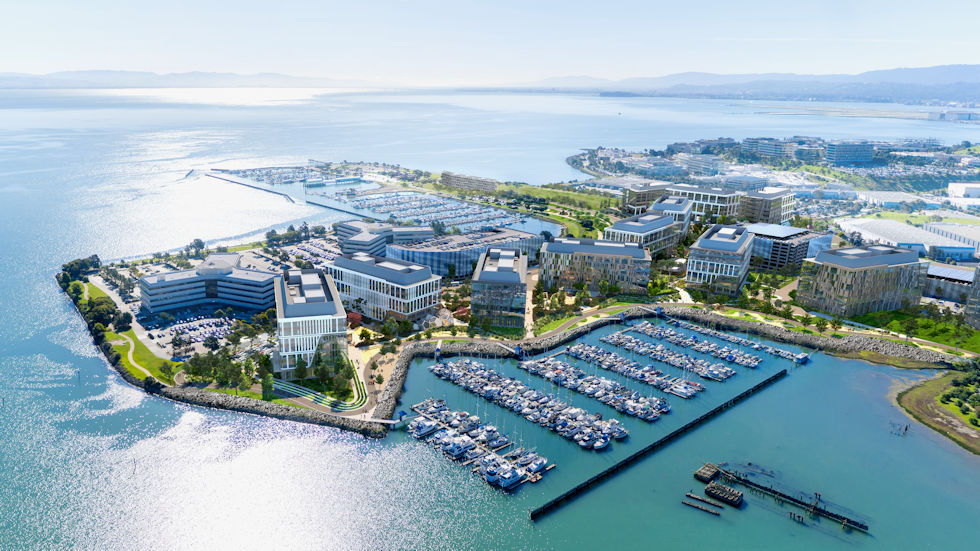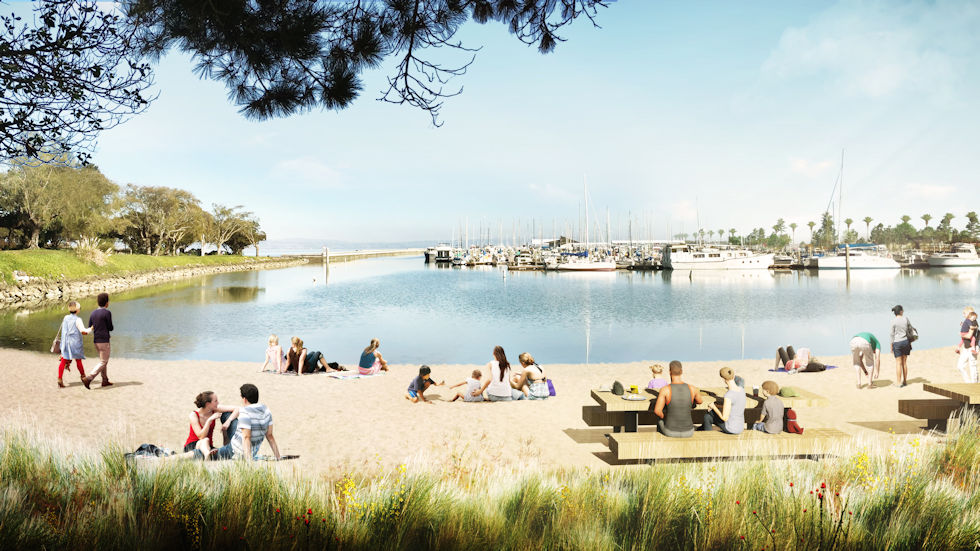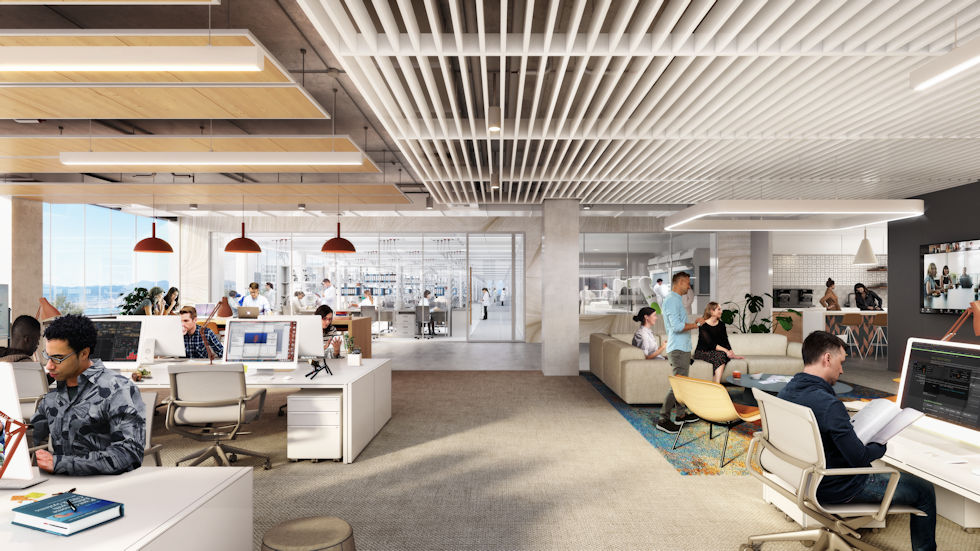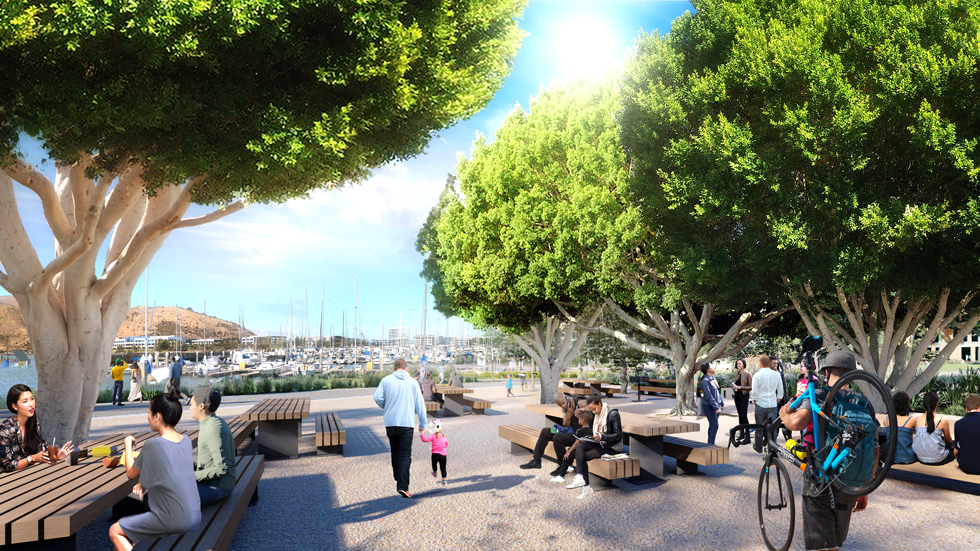Kilroy Realty Corp. is leading the development of Oyster Point, a life science hub that will bring numerous work and life amenities to South San Francisco.
The importance of life science research during the COVID-19 pandemic has underscored the growing need for more high caliber laboratory space, especially in the San Francisco Bay area, one of the largest science industry clusters in the United States.
In 2016, Kilroy Realty Corporation (NYSE: KRC), an industry leader of work environments to the tech industry, significantly expanded its life science portfolio to reflect the demands in the market for laboratory and life science offices that support cutting edge research.
"We've taken the same philosophy that has been successful in our tech developments," says John Kilroy, chairman and CEO of Kilroy Realty. "We provide work environments that really ignite innovation and help companies to retain their most important asset— their people."
In June, REIT broke ground on phase two of its 3 million-square foot, 12-building, 50-acre waterfront life science campus, Kilroy Oyster Point in South San Francisco. The latest phase will include three buildings, roughly 900,000 square feet of space and new amenities that support wellness, connection, and productivity.
The ongoing development of Oyster Point marks the evolution of South San Francisco as a life science hub and will bring local conveniences like an urban village that includes an outdoor amphitheater, outdoor meeting spaces, a state-of-the-art conference center, and a full service restaurant to the newly enhanced waterfront site.
"The buildings are beautiful and will bring new, clean, high-paying jobs here and bolster our local economy," says Mike Futrell, city manager for the city of South San Francisco. Plans for KOP look to incorporate community access to the natural resources and waterfront setting along the San Francisco Bay while catalyzing far-reaching scientific research and development.
"Oyster Point will have tangible benefits for the city of South San Francisco, but it really goes beyond that to a higher purpose," Futrell says. "Since COVID-19, there has been a lot of emphasis on life science research and our capacity as a country to respond to pandemics and variants. Kilroy is delivering something special that will benefit this industry for a long time to come," he adds.
Sharing a Vision
The area that would become Kilroy Oyster Point was previously a landfill closed in the 1970s and capped for safety. "We were looking for a partner who had a vision of taking an ugly duckling and turning it into a beautiful swan," Futrell says, in reference to the Oyster Point area prior to development. "The area was environmentally contained, but we knew it could be so much more being that it's San Francisco Bay," he adds.
It would take several years and key transactions to bring this dream to fruition. Historically overlooked by developers and travelers favoring its namesake just 10 miles to the north, South San Francisco has gradually evolved into an up-and-coming technology and life science arena that offers much of the same natural allure without the hefty price tag of San Francisco.
"In the last few years, we've seen the South San Francisco area start to grow and evolve, so our hope was that our waterfront on San Francisco Bay would be redeveloped in a way that was special and unique, something that we can be proud of," Futrell says.
Kilroy Realty had a similar vision, and the timing was right. "We saw a massive potential for the site," Kilroy says, "not only to create a world class life science destination but to activate the entire Oyster Point area, which is a large section of the city of South San Francisco." The REIT purchased the fully-entitled land site through an off market transaction in 2018 from a group of five China-based companies that lacked a unified vision for the redevelopment of the site, the company says.
"From our first meeting with Kilroy, we knew we shared a common vision for South San Francisco," says Futrell, who describes the city's collaboration with the REIT as a "partnership in every aspect." Together, the city and Kilroy Realty's team have collaborated on architecture, infrastructure for parks, and approaches to longterm maintenance.
Unlike the greater Bay area's notoriously fraught development reputation, Kilroy Realty found an accommodating and straightforward path to developing Oyster Point. "South San Francisco is very good to work with— they are expedient and responsive. They've embraced our vision and we've embraced theirs, so it's a virtuous cycle that also allows us to increase neighborhood access to these amenities," Kilroy says.
Preparing for Rising Sea Levels
The fruits of this collaboration include creating a commercial hub with dining and outdoor amenities, new ferry terminals for waterway access on the Bay, a boutique hotel, and playing fields that appeal to tenants and locals alike. "We've worked with Kilroy on not just what would be built, but how we would share the responsibilities for these amenities in the future," Futrell says. The benefits to the community will be tangible and long term, he adds. Oyster Point includes a series of parks and trails along the waterfront, a marina, as well as a public park with a revitalized sandy beach with dedicated dropoffs, parking, picnic tables, and restrooms.
The plans for Oyster Point also take into account the broader Bay area's natural resources. Oyster Point's shoreline will connect with the San Francisco Bay Trail, a planned 500-mile walking and cycling path around the entire San Francisco Bay running through all nine Bay Area counties, 47 cities, and seven toll bridges.
With more than 350 miles already in place, Kilroy Oyster Point will further connect communities to forms of alternative commuter transit. "Our team has worked closely with the San Francisco Bay Conservation and Development Commission (BCDC), which manages the preservation and conservation of the San Francisco Bay, in order to provide a terrific public experience for those utilizing the Bay trail," says Matt Griffin, senior vice president, Northern California, at Kilroy Realty.
Ferries will improve local and commuter access. "We're very excited about implementing a water transit strategy, which will not only benefit the tenant partners but the greater community of individuals that commute and residents," Kilroy says. "The Bay is a great way to get around because you don't have all of the fixed infrastructure requirements and the same public domain issues that you have on the roads," he adds.
Kilroy's planning for Oyster Point also factors in climate change. "One of the long-term benefits is that they are preparing us for sea level rise," Futrell notes. "Oyster Point will raise that portion of the land to account for the studies that show how the sea level will rise in the next 50 to 100 years. Kilroy is fortifying this area of the city against this rise," he says.
Incubating Ideas
Futrell and the city of South San Francisco are not alone in their enthusiasm for being a part of global medical and life science research initiatives. Kilroy Realty also sees the potential benefits of Oyster Point reaching far beyond South San Francisco as an investment in critical life science research infrastructure.
The San Francisco Bay area is widely considered to be one of the top two largest life science clusters in the U.S., along with Boston-Cambridge, Massachusetts. South San Francisco, meanwhile, is home to the largest biotech cluster in the world with more than 200 biotech companies, according to the city. Life science leasing activity "hasn't skipped a beat" during the pandemic, according to Griffin. "The very nature of the life science industry is fighting disease. The industry is crucial to the pandemic response," he says.
There's also an organic synergy with the market. According to the Kilroy Realty team, a third of all the companies working directly on the COVID- 19 response have a presence in the Bay Area, occupying more than 10 million square feet of leasing space. "Our region is a major component in the life science ecosystem on a national and international scale," Griffin says.
Life science research also requires laboratory usage, which means work-from-home arrangements are less plausible than in the tech market. "If you consider a lack of work-from-home dynamic, along with a record amount of [venture capital] funding pouring into the life science industry, which is exploring everything from oncology research to fighting infectious diseases, there's a huge amount of demand for lab space in the Bay Area," Griffin adds.
This market demand also aligns with the REIT's larger goals."Our vision is to continue to grow our portfolio in the best clusters with best-in-class products that deliver products that are sustainable, scalable, flexible, and amenity-driven," Kilroy says. In addition to Oyster Point, Kilroy Realty has invested in several properties in San Diego, as well as in Mission Bay, San Francisco.
'Next-Level' Impact
The response from biopharmaceutical and tech industries to Kilroy Oyster Point's offerings and groundbreaking has been immediate and enthusiastic. Within seven months of starting construction on phase one in early 2019, the REIT had entirely leased more than 650,000 square feet as the headquarters for two companies—Cytokinetics, a biopharmaceutical company and Stripe, a popular tech company behind payment processing software used for websites and mobile applications.
According to Griffin, phase two is expected to see shell completion in the early first quarter of 2024. Phases three and four are ready to begin, pending market conditions-which currently look strong-and would take 30 months to construct post-groundbreaking.
The size of the 50-acre campus and various outdoor amenities have only made Kilroy Oyster Point all the more attractive during the ongoing pandemic social distancing limitations. "We've enhanced certain aspects like filtration systems and building ventilation capabilities to address pandemic needs and we've incorporated touchless technology on the campus," Griffin says. A variety of outdoor meeting spaces and amenities allow for stronger collaboration opportunities.
Kilroy credits the combined architectural, consulting, and internal teams for coming up with "next-level" designs that attract such top-level talent. "Next-level is basically what nobody's done before—it's creating buildings with dual purposes that can last lifetimes," he says.
Next-level design also aligns with Kilroy Realty's documented commitment to sustainability and connecting their tenants with the environment. "Work is such a big part of your life. It should be exciting, and it should connect you to nature where it can," Kilroy says.
With Kilroy Oyster Point, both incoming tenants and residents of South San Francisco will have access to the Bay like never before. "Our hope was for a redevelopment of this entire waterfront to make it a destination, both for people that work in the buildings, and also for residents and visitors to the city. That is what is being delivered," Futrell says.



